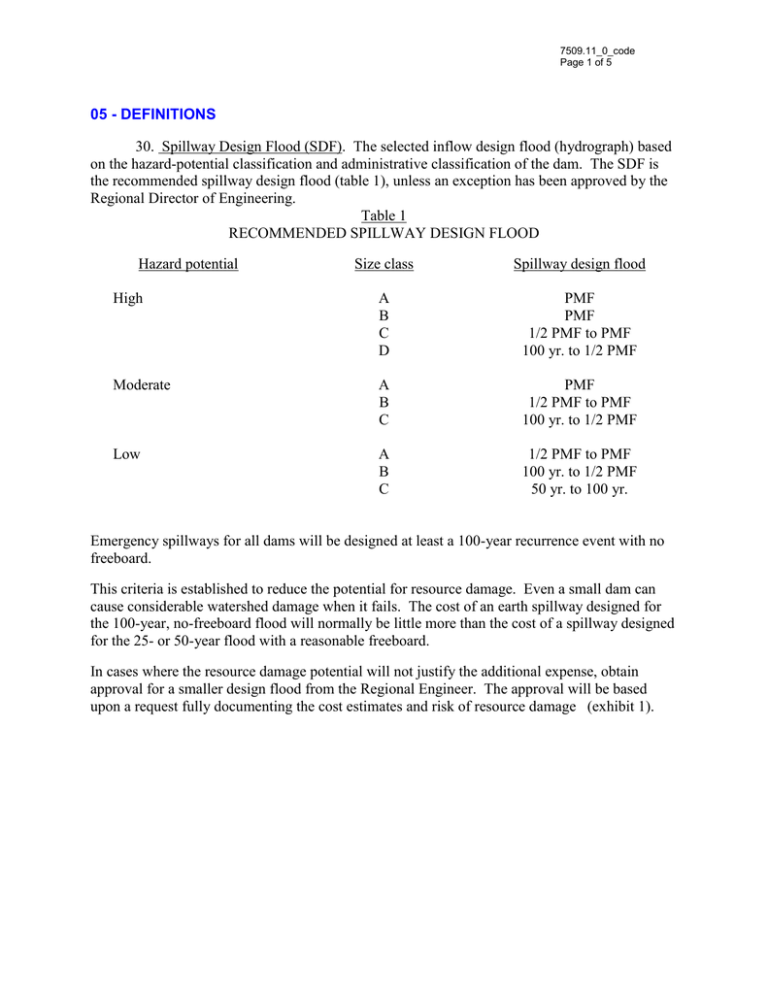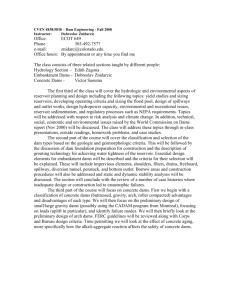05 - DEFINITIONS
advertisement

7509.11_0_code Page 1 of 5 05 - DEFINITIONS 30. Spillway Design Flood (SDF). The selected inflow design flood (hydrograph) based on the hazard-potential classification and administrative classification of the dam. The SDF is the recommended spillway design flood (table 1), unless an exception has been approved by the Regional Director of Engineering. Table 1 RECOMMENDED SPILLWAY DESIGN FLOOD Hazard potential Size class Spillway design flood High A B C D PMF PMF 1/2 PMF to PMF 100 yr. to 1/2 PMF Moderate A B C PMF 1/2 PMF to PMF 100 yr. to 1/2 PMF Low A B C 1/2 PMF to PMF 100 yr. to 1/2 PMF 50 yr. to 100 yr. Emergency spillways for all dams will be designed at least a 100-year recurrence event with no freeboard. This criteria is established to reduce the potential for resource damage. Even a small dam can cause considerable watershed damage when it fails. The cost of an earth spillway designed for the 100-year, no-freeboard flood will normally be little more than the cost of a spillway designed for the 25- or 50-year flood with a reasonable freeboard. In cases where the resource damage potential will not justify the additional expense, obtain approval for a smaller design flood from the Regional Engineer. The approval will be based upon a request fully documenting the cost estimates and risk of resource damage (exhibit 1). 7509.11_0_code Page 2 of 5 Exhibit 1 CALCULATED RISK DIAGRAM 1/ 1000 | | | | | 7 | 15 | 30 | 70 800 600 500 400 300 200 150 100 75 50 25 10 5 2 1 1 2 5 10 20 DESIRED LIFETIME, Td (Years) 1 After U.S. Weather Bureau TP 40 50 100 7509.11_0_code Page 3 of 5 08 - REFERENCES. The listed publications are not all inclusive, but they are representative of Federal agency and other publications available relative to water storage and transmission structures. 1. Federal Guidelines for Dam Safety. These guidelines outline good management practices for dam safety for all Federal agencies responsible for the planning, design, construction, operation, or regulation of dams. They are not intended as standards for technology of dams. The basic principles of the guidelines apply to all dams. Reasonable judgments need to be made in their application commensurate with each dam's size, complexity, and hazards. The information in the guidelines is subject to change as the state of the science develops. 2. Engineering Foundations Conference Proceeding published by the American Society of Civil Engineers: a. Inspection, Maintenance and Rehabilitation of Old Dams, 1973. b. Foundations For Dams, 1974. c. Safety of Small Dams, 1974. d. Responsibility and Liability of Public and Private Interest on Dams, 1975. e. The Evaluation of Dam Safety, 1976. 3. Joint ASCE/USCOLD publications, published by the American Society of Civil Engineers: a. Arch Dams Embankment Dams & Concrete Gravity Dams, 1967. b. Lessons From Dam Incidents, USA, 1975. 4. BUREAU OF RECLAMATION a. Earth Manual, Second Edition, 1974 b. Ground Water Manual, First Edition, 1977. c. Design of Gravity Dams, First Edition, 1976. d. Design of Arch Dams, First Edition, 1977. e. Design of Small Dams, Second Edition, 1973. f. Manual for Safety Evaluation of Existing Dams, Preliminary, 1977. g. Design of Small Canal Structures, First Edition, 1974. h. Safety Evaluation of Existing Dams (SEED) Manual, 1980. 7509.11_0_code Page 4 of 5 5. CORPS OF ENGINEERS a. Engineering Manuals (EM): EM 1110-2-1602 Hydraulic Design of Reservoir Outlet Structures -1603 Hydraulic Design of Spillways -1902 Stability of Earth & Rockfill Dams -1908 Instrumentation of Earth and Rockfill Dams -1911 Construction Control for Earth and Rockfill Dams -2200 Gravity Dam Design -2300 Earth and Rockfill Dams General Design and Construction Considerations -1601 Hydraulic Design of Flood ControlChannels b. Engineering Reports (ER): ER 1110-2-1450 Hydrologic Frequency Estimates -1806 Earthquake Design and Analysis for Corps of Engineers Dams 6. Soil Conservation Service, National Engineering Handbooks. 7. Technical Publication, National Weather Service. 8. Forest Service a. "Guide for Safety Evaluation and Periodic Inspection of Existing Dams (EM7570-1)," 1980, U.S. Forest Service and Soil Conservation Service. Although this book is out of print and will not be reprinted, any copies presently in circulation may be used. The information is still valid. b. "Operation and Maintenance Inspection for Dams (EM-7570-2)," 1981, USDA Forest Service. Although this book is out of print and will not be reprinted, any copies presently in circulation may be used. The information is still valid. 9. GENERAL a. Seepage, Drainage, and Flow Nets, Cedergreen, 1977, Wiley. b. Embankment - Dam Engineering, Casagrande, 1973, Wiley-Interscience. 7509.11_0_code Page 5 of 5 c. Earth and Earth-Rock Dams, Sherard, Woodward, Gizienski and Clevenger, 1963, Wiley. d. Handbook of Hydraulics, King and Brater, Fifth Edition, 1963, McGraw-Hill. e. Open-Channel Hydraulics, Chow, 1959, McGraw-Hill. f. Fundamentals of Earthquake Engineering, Newmark and Rozenbleuth, 1971, Prentice-Hall. g. "Glossary of Geology and Related Sciences," American Geological Institute. h. Standards of the American Society for Testing and Materials, as cited. i. Standards of the American Water Works Association, as cited. j. "Subsurface Exploration and Sampling of Soils for Civil Engineering Purposes," Hvorslev, Engineering Foundation, New York, New York. k. Standards of the American Concrete Institute, as cited. l. Standards of United States of America Standards Association. The technical principles, practices, and guidelines for existing dams follow those established for the planning, design, and construction of new structures. Users should refer to FSM 2710, 2720, and 2780 for additional information on structures under special-use authorization, and to FSM 2770 for those licensed by the Federal Energy Regulatory Commission. These references and others, if appropriate, should be available and kept current in each engineering office where work of the nature described in this handbook is performed.







